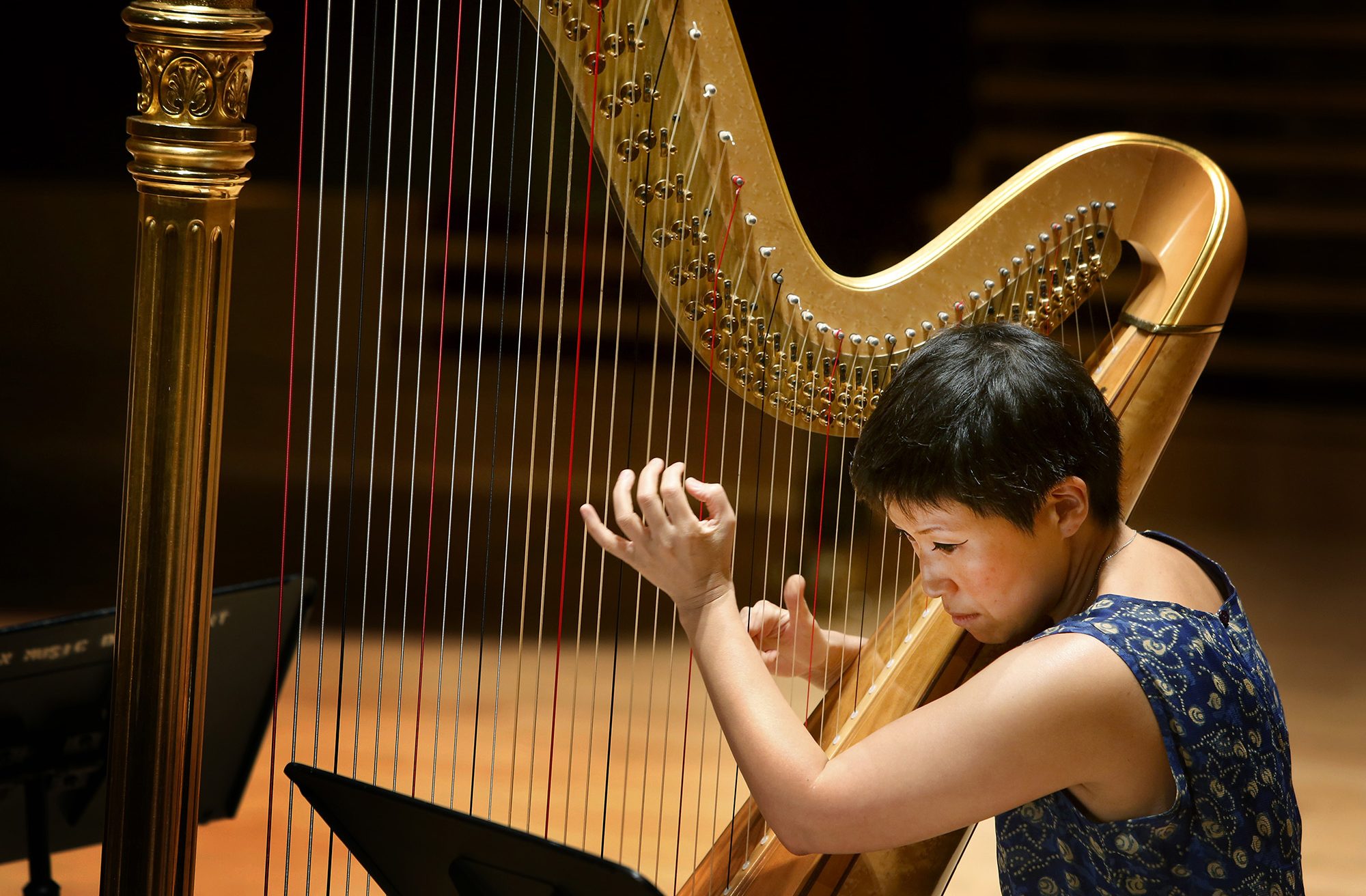Bach, Takemitsu, Elgar: July 31, 2019
Takemitsu’s soft spoken Toward the Sea was written originally for Greenpeace’s ‘Save the Whales’ campaign in 1981, performed here in its arrangement for alto flute and harp. Drawing upon Herman Melville, the work includes movements titled ‘Moby Dick’ and ‘Cape Cod’. The atmosphere of Elgar’s Piano Quintet, meanwhile, conjures a more foreboding atmosphere – ‘wonderful’ and ‘weird’, as Alice Elgar wrote, ‘evidently reminiscent of sinister trees…’
JOHANN SEBASTIAN BACH
Trio Sonata in G Major, BWV 1038
In 1729, Bach was appointed director of the Collegium Musicum in Leipzig, the city where he had been serving as ‘Thomaskantor’ (Cantor and Music Director at the church of St. Thomas) since 1723. In his role as Thomaskantor, Bach was tasked with directing the church’s boys choir and providing choral music for the city’s major Lutheran churches. However, the Collegium Musicum called for very different sorts of music-making. Founded in 1702 by Georg Philipp Telemann, the Collegium Musicum was a predominantly secular music society. Volunteer musicians (many university students) gathered to perform vocal and instrumental music, giving weekly concerts at Leipzig’s most prominent Kaffeehaus, the Café Zimmerman. These concerts were free to attend, with Zimmerman selling plenty of coffee to cover costs.
For Bach, who had been occupied by composing sacred music for the majority of the decade, the new position offered him the outlet to explore musical genres such as secular cantatas (including the famed “Coffee Cantata”), as well as instrumental concertos and chamber music. Bach is believed to have taken advantage of the confluence of the Collegium’s high-caliber instrumentalists and eager, discerning audiences, in order to experiment with novel compositional techniques – including, for example, the expansion of the role of the harpsichord in sonata contexts from the continuo role to an increasingly independent actor. And yet, like his sacred music, much of the music Bach produced was ephemeral and has since been lost.
The Trio Sonata BWV 1038, composed during these years, is one of only a handful of Bach Trio Sonatas to have survived. Certain scholars have suggested that the work was composed, at least in part, by one of Bach’s illustrious sons, Carl Philipp Emmanuel. For one, the harpsichord part, in contrast to contemporaneous examples, maintains a relatively restrained continuo role. One possibility is that the piece was composed “jointly”, as it were – with Johann Sebastian providing the bassline structure, and his son filling in the melodies, rather like an apprentice in a studio.
TŌRU TAKEMITSU
Toward the Sea III
Water has proved a remarkably fecund source of inspiration for Tōru Takemitsu. In 1960, he composed Water Music, a piece for tape for which he manipulated the recorded sounds of water droplets. And in the 1970s and 80s, Takemitsu composed a long string of works bearing links to the water. In addition to his three versions of Toward the Sea, further examples include Garden Rain(1974), Waves(1976), Rain Tree(1981), riverrun(1984), The Sea is Still(1986), and I Hear the Water Dreaming(1987) – to name only a few. Many of these works are linked through Takemitsu’s “sea” motif, a musical spelling of the word “sea” itself, using E-Flat (known as “Es” in German)—E—A. These three notes, according to Takemitsu, “motivate the melody”.
Toward the Seawas commissioned by the environmental organization, Greenpeace, as part of their “Save the Whales” campaign. The campaign targeted commercial whaling, which had ballooned to industrial proportions by the mid–twentieth century and threatened to extinguish several species of whales, with dire consequences for marine ecosystems. The work was composed initially in 1981, scored for alto flute and guitar; that same year, arranged the work for alto flute, harp, and string orchestra. Finally, in 1988, he composed a third and final version (III), for alto flute and harp alone. Takemitsu drew the work’s structure and imagery from literature’s most famous whale, Moby-Dick, creating what he called a “pastoral, picture-like piece”. In the composer’s words, “the music is a homage to the sea which creates all things and a sketch for the sea of tonality.”
EDWARD ELGAR
Piano Quintet in A Minor, Op. 84
The spooky strangeness of Elgar’s Piano Quintet made a strong impression on his close friends and family. His wife, Lady Alice Elgar, wrote that the Quintet was “evidently reminiscent of sinister trees…sad ‘dispossessed’ trees and their dance and unstilled regret for their evil fate—or rather curse…” Elgar himself was rather more succinct: “It’s ghostly stuff”.
Elgar composed the piece in 1918. Now in his sixties, he had rented a cottage in the South English countryside near Fittleworth, a small village which had inspired atmospheric paintings by Turner and Constable in the previous century. It was here that he composed his famous Cello Concerto, and undertook a wave of chamber music that also included his Violin Sonata and a string quartet – Elgar’s first serious forays in chamber music since the 1880s. Like the painters before him, Elgar was bewitched by the austerity of the natural surroundings, including the uncannily crooked limbs of the trees. According to local legend, the trees were the frozen bodies of Spanish monks, punished by lightning strikes for performing unholy rituals – imagery which may have appealed to Elgar’s own tastes for the esoteric and mystical.
The atmosphere is established from the Quintet’s opening notes, what Lady Elgar called the work’s “wonderful, weird beginning”. Sparse, sustained octaves in the piano are punctuated with tremulous stutters in the strings, marked serioso– any sense of direction is suspended. Then, a slinking proposition comes forth in the upper strings, a plea in the cello, and at last the piano fills out the texture. Only after a minute does a spirit theme arrive in Allegro, setting off the rest of the movement in a Brahmsian texture of expansive piano writing – soon to be interrupted by recollections of the opening mood.

